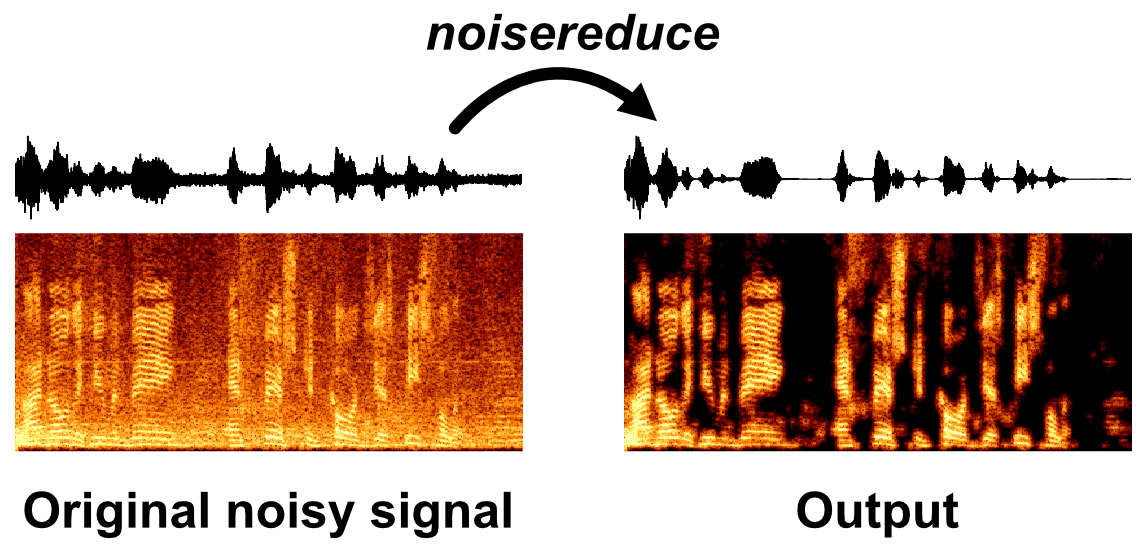timsainb / Noisereduce
Licence: mit
Noise reduction in python using spectral gating (speech, bioacoustics, time-domain signals)
Stars: ✭ 347
Labels
Projects that are alternatives of or similar to Noisereduce
Deeppurpose
A Deep Learning Toolkit for DTI, Drug Property, PPI, DDI, Protein Function Prediction (Bioinformatics)
Stars: ✭ 342 (-1.44%)
Mutual labels: jupyter-notebook
Machine Learning
Content for Udacity's Machine Learning curriculum
Stars: ✭ 3,618 (+942.65%)
Mutual labels: jupyter-notebook
Pytorch Cortexnet
PyTorch implementation of the CortexNet predictive model
Stars: ✭ 349 (+0.58%)
Mutual labels: jupyter-notebook
Coursera Deep Learning Deeplearning.ai
(完结)网易云课堂微专业《深度学习工程师》听课笔记,编程作业和课后练习
Stars: ✭ 344 (-0.86%)
Mutual labels: jupyter-notebook
Nlp Papers With Arxiv
Statistics and accepted paper list of NLP conferences with arXiv link
Stars: ✭ 345 (-0.58%)
Mutual labels: jupyter-notebook
Fast Pytorch
Pytorch Tutorial, Pytorch with Google Colab, Pytorch Implementations: CNN, RNN, DCGAN, Transfer Learning, Chatbot, Pytorch Sample Codes
Stars: ✭ 346 (-0.29%)
Mutual labels: jupyter-notebook
Keras Oneshot
koch et al, Siamese Networks for one-shot learning, (mostly) reimplimented in keras
Stars: ✭ 348 (+0.29%)
Mutual labels: jupyter-notebook
Pytorch Tutorials Examples And Books
PyTorch1.x tutorials, examples and some books I found 【不定期更新】整理的PyTorch 1.x 最新版教程、例子和书籍
Stars: ✭ 346 (-0.29%)
Mutual labels: jupyter-notebook
Kaggle competition treasure
Describe past Kaggle solutions
Stars: ✭ 346 (-0.29%)
Mutual labels: jupyter-notebook
Nbval
A py.test plugin to validate Jupyter notebooks
Stars: ✭ 347 (+0%)
Mutual labels: jupyter-notebook
T81 558 deep learning
Washington University (in St. Louis) Course T81-558: Applications of Deep Neural Networks
Stars: ✭ 4,152 (+1096.54%)
Mutual labels: jupyter-notebook
Ml cheat sheet
My notes and superstitions about common machine learning algorithms
Stars: ✭ 349 (+0.58%)
Mutual labels: jupyter-notebook
Amazon Forest Computer Vision
Amazon Forest Computer Vision: Satellite Image tagging code using PyTorch / Keras with lots of PyTorch tricks
Stars: ✭ 346 (-0.29%)
Mutual labels: jupyter-notebook
Noise reduction in python using spectral gating
- This algorithm is based (but not completely reproducing) on the one outlined by Audacity for the noise reduction effect (Link to C++ code)
- The algorithm takes two inputs:
- A noise audio clip containing prototypical noise of the audio clip (optional)
- A signal audio clip containing the signal and the noise intended to be removed
Steps of algorithm
- An FFT is calculated over the noise audio clip
- Statistics are calculated over FFT of the the noise (in frequency)
- A threshold is calculated based upon the statistics of the noise (and the desired sensitivity of the algorithm)
- An FFT is calculated over the signal
- A mask is determined by comparing the signal FFT to the threshold
- The mask is smoothed with a filter over frequency and time
- The mask is appled to the FFT of the signal, and is inverted
Installation
pip install noisereduce
noisereduce optionally uses Tensorflow as a backend to speed up FFT and gaussian convolution. It is not listed in the requirements.txt so because (1) it is optional and (2) tensorflow-gpu and tensorflow (cpu) are both compatible with this package. The package requires Tensorflow 2+ for all tensorflow operations.
Usage
import noisereduce as nr
# load data
rate, data = wavfile.read("mywav.wav")
# select section of data that is noise
noisy_part = data[10000:15000]
# perform noise reduction
reduced_noise = nr.reduce_noise(audio_clip=data, noise_clip=noisy_part, verbose=True)
Arguments to noise_reduce
n_grad_freq (int): how many frequency channels to smooth over with the mask.
n_grad_time (int): how many time channels to smooth over with the mask.
n_fft (int): number audio of frames between STFT columns.
win_length (int): Each frame of audio is windowed by `window()`. The window will be of length `win_length` and then padded with zeros to match `n_fft`..
hop_length (int):number audio of frames between STFT columns.
n_std_thresh (int): how many standard deviations louder than the mean dB of the noise (at each frequency level) to be considered signal
prop_decrease (float): To what extent should you decrease noise (1 = all, 0 = none)
pad_clipping (bool): Pad the signals with zeros to ensure that the reconstructed data is equal length to the data
use_tensorflow (bool): Use tensorflow as a backend for convolution and fft to speed up computation
verbose (bool): Whether to plot the steps of the algorithm
Citation
If you use this code in your research, please cite it:
@software{tim_sainburg_2019_3243139,
author = {Tim Sainburg},
title = {timsainb/noisereduce: v1.0},
month = jun,
year = 2019,
publisher = {Zenodo},
version = {db94fe2},
doi = {10.5281/zenodo.3243139},
url = {https://doi.org/10.5281/zenodo.3243139}
}
or
@article{sainburg2020finding,
title={Finding, visualizing, and quantifying latent structure across diverse animal vocal repertoires},
author={Sainburg, Tim and Thielk, Marvin and Gentner, Timothy Q},
journal={PLoS computational biology},
volume={16},
number={10},
pages={e1008228},
year={2020},
publisher={Public Library of Science}
}
Project based on the cookiecutter data science project template. #cookiecutterdatascience
Note that the project description data, including the texts, logos, images, and/or trademarks,
for each open source project belongs to its rightful owner.
If you wish to add or remove any projects, please contact us at [email protected].

